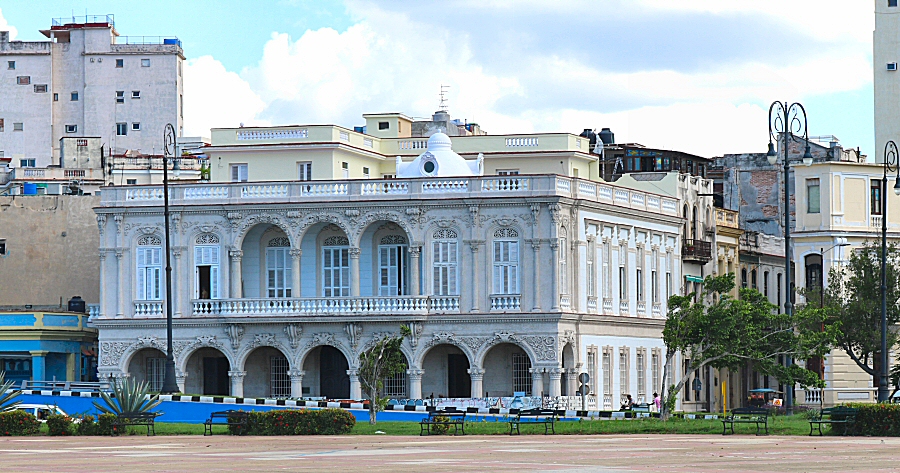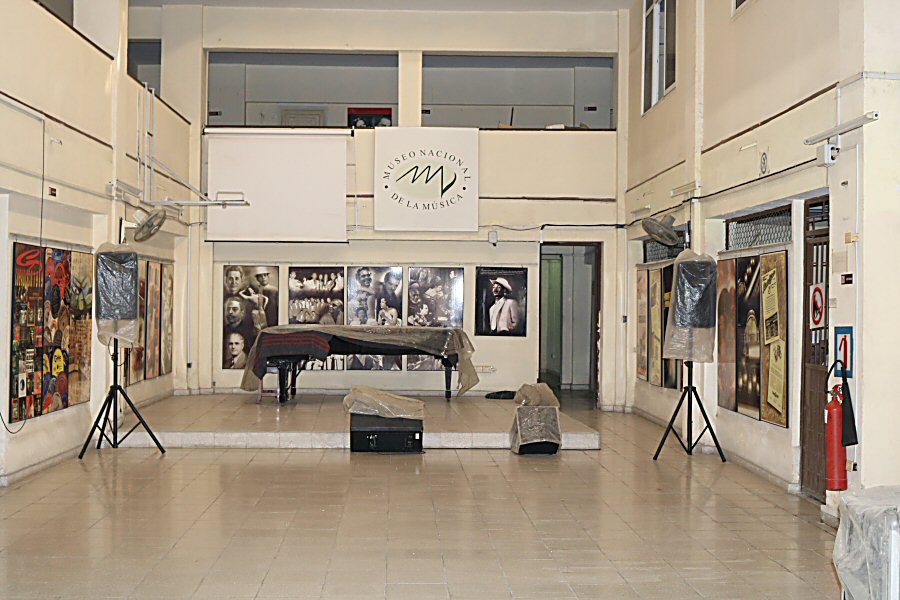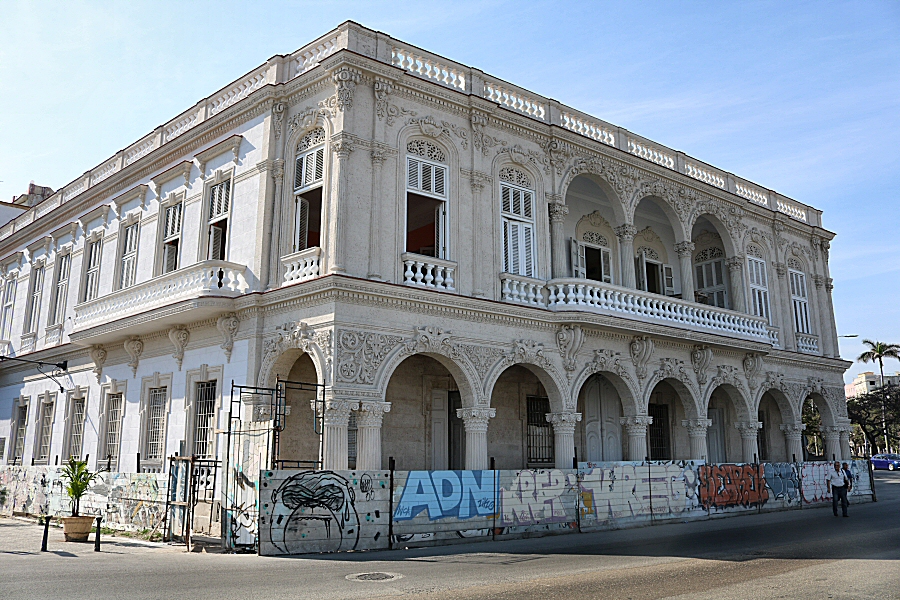


The building of the Museo Nacional de la Musica was built by a wealthy Creole merchant as a residence in 1905. Later, it was occupied by another aristocratic Cuban family. In 1936 the government took the possession of the residence to install the Secretary of State. In 1971 the headquarter of the Museum and the National Music Archive was established in this building. After a restoration in 1981, it opened its doors to the public with ten exhibition halls. In 1998 the Musical Information and Documentation Center "Odilio Urfé" was incorporated in the museum, so that it received the name the Museo Nacional de la Música. In 2007 the collection of the museum was moved to the building on the Obrapia street to be able to carry out a through restoration in the old building, thereby increasing the quality of the services, updated with the equipment of the latest technology.
 Currently, the building on
the Capdevila street #1 is under restoration and the the Museo
Nacional de la Música is rendering service to the public in the
building on the Obrapia street #509, between the Berneza and the
Villegas streets.
Currently, the building on
the Capdevila street #1 is under restoration and the the Museo
Nacional de la Música is rendering service to the public in the
building on the Obrapia street #509, between the Berneza and the
Villegas streets.
As mentioned before, the Museo
Nacional de la Música came to existence by joining the Museum
and the National Music Archive and the Musical Information and
Documentation Center "Odilio Urfé".
The Museum and the National Music
Archive was established under the direction of the pianist,
pedagogue and researcher María Antonieta Henríquez. The majority
of the collections of the museum consisted of important
donations, such as musical instruments, works of art, furniture,
musical players and documents.
The Musical Information and
Documentation Center "Odilio Urfé" dates back to 1949, when the
Musical Institute of Folklore Investigations (Instituto Musical
de Investigaciones Folklóricas) was established by the pianist
and musicologist Odilio Urfé González. The objectives of the
institute were collecting, preserving, studying and
disseminating the Cuban musical heritage for all times. After a
self-sacrificing work of 15 years, in that the institute
remained standing only by the support of its members, it passed
to the hands of the National Council of Culture that added the
pedagogical function to it, by changing its name to Cuban Music
Seminar in 1964. After the death of Odilio Urfé González, it
served only as a documentation center that constituted
essentially of the private manuscript collection of the Urfé
family from the 19th to 20th centuries. The Musical Information
and Documentation Center "Odilio Urfé" is considered the oldest
Cuban center that was dedicated to the study and conservation of
the Cuban music.
The archive of the museum consists of
donations, made by outstanding personalities, such as the
pedagogues, musicians, directors of orchestras, founders of
academies, as well as institutions related to music, and musical
groups. The donations can be grouped in different types of
documents (correspondences, manuscripts, personal notes, concert
programs, photos, scores, certifications, diplomas, medals,
regulations, teaching materials, methods, etc.) that constitute
the Cuban musical historical memory. Gaspar Agüero, Jorge
Anckermann, Ernesto Lecuona, Rita Montaner, María Muñoz de
Quevedo, Odilio Urfé, Gonzalo Roig, Hubert de Blanck are among
the most outstanding donators. The archive was enriched also by
the donations of the musical groups, such as the unforgettable
orchestras Los Caciques, Riverside, Filarmónica , and of the
popular groups of the time Casino and Palmas y Cañas , as well
as the Music Band of the Central District of Havana, directed by
maestro Guillermo Tomás, La Banda Municipal de la
Habana, directed by maestro Gonzalo Roig, among others. One
should also not forget the donations of the institutions like
the María Jones de Castro International Conservatory, the
Benjamin Orbón Conservatory, the Normal School of Music, and the
Musical Art Club of Santa Clara.
The collection of the museum was
enriched by the handwritten scores of important Cuban composers,
such as Ernesto Lecuona, Dámaso Pérez Prado, Miguel Faílde and
Alejandro García Caturla, and by the the old editions of the
scores of José Mauri, Gonzalo Roig, Alejandro García Caturla,
Hubert de Blanck, Amadeo Roldán, José White, Eduardo Sanchez de
Fuentes, Guillermo Tomás, Erich Kleiber, but the most important
document that had a special value, was the original score of the
National Anthem. The manuscript scores of Esteban Salas Castro
from the 18th century that is considered the first Cuban
composer, were without doubt the most ancient among the document
collections of the museum. A collection of scores from the old
Tacón Theater and the musical theater written by Jorge
Anckermann are the unique pieces of the archive of the museum.
The photographic archives and press
clippings, on the other hand, are considered among the most
complete of their kind in Cuba -fundamentally in Cuban popular
music.
In the library you can find many books
about the Cuban musical historiography of the 19th and 20th
centuries, as well as some works of the Hispanic American and
universal musical literature. The library contains the main
publications of music published in Cuba, among them Musicalia,
Pro Arte Musical, Clave and the Casa de las Américas Music
Bulletin, that deal with musical events that took place on the
Island throughout the 20th and early 21st centuries.
The Sound Library contains a lot of
sound recordings that belong to the Cuban music of all times,
styles and genres (instrumental, popular, symphonic), as well as
interviews on the subject of music. They are recorded on almost
all types of media, manufactured by the music industry, from
cylinders (phonograph records) to DVD’s. There are about 50
cylinders on that the operas, language lessons and hymns were
recorded, among which the National Anthem of Cuba and the
Invader Anthem (a hymn created by the commander Enrique Loynaz
del Castillo in Camagüey in 1895, representing the bravery of
those who fell during the fight in 1868) that date back to 1917,
stand out.
The façade of the two-storey building
is of ashlar masonry. The portico features solid Corinthian
columns imitating the Italian renaissance.
